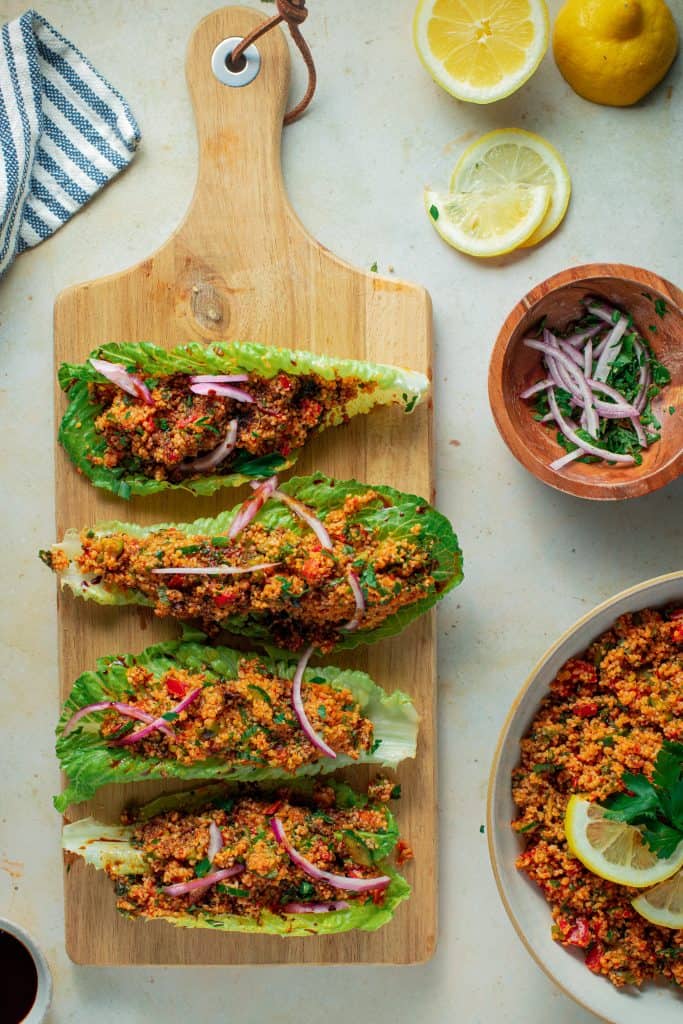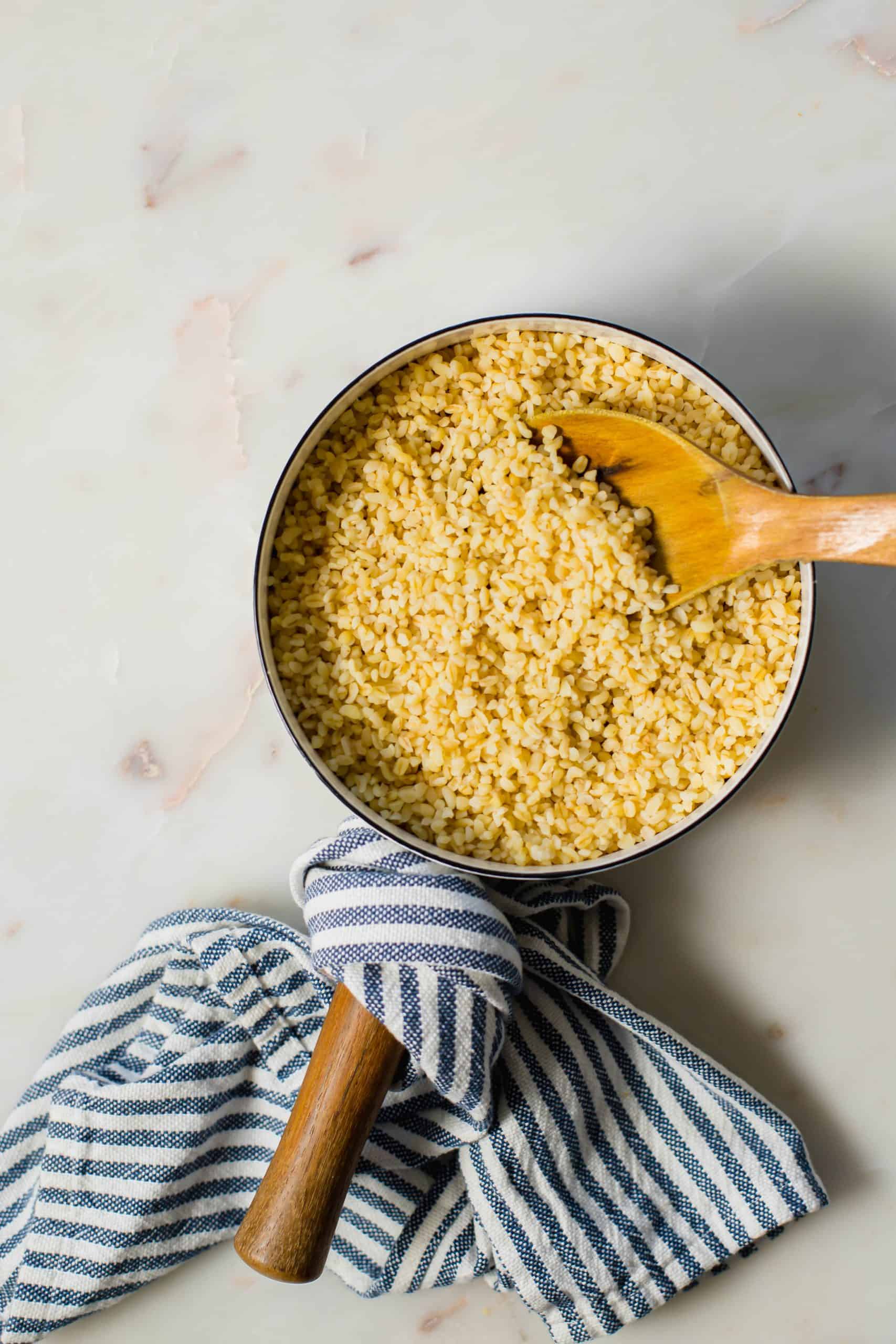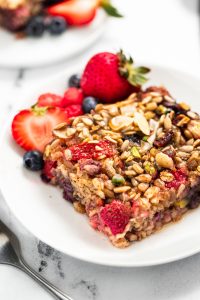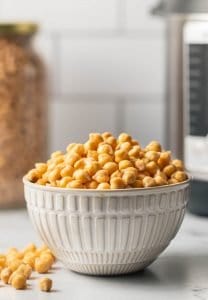Savoury, fluffy and a refreshing change from the old standard sides, cooking bulgur wheat is easier to achieve than you might think. Let's deep-dive into how to cook bulgur wheat. This tasty ancient whole grain is quick to cook and jam-packed full of protein, fibre, and vitamins! It'll be a family favourite in no time.

Bulgur may be a mystery grain to many in the West, but this ancient whole grain is very common in the Middle East. It is the essential grain of the Middle Eastern Mediterranean. It is tasty, easy and fast to make. ⏤ You'll wonder why it wasn't on your table sooner.
What is Bulgur?
Bulgur is a whole grain of wheat that has been parboiled, dried, and cracked into different coarse grades. Thanks to the parboiling process, this ancient grain cooks fast and easy.
Types of Bulgur
There are four different coarse grades of bulgur, they range from very fine to very coarse. This means each coarse grade offers opportunities for different uses:
- Fine # 1: this bulgur is most often found in tabouli and kibbeh. It's also used thickener for many Turkish recipes
- Medium # 2: use this grade for salads, side dishes, and pilafs
- Coarse # 3: extra chewy, reserved more for pilafs and stuffings.
- Coarse # 4: it's hard to find this one, I know it's out there somewhere. You would use it the same as #3
- Available in both white and dark colours too, the white bulgur has been husked, so a less earthy flavour.
- Some kinds also have toasted pasta mixed in! Those are my favourite ones.
Where do you find Bulgur?
You can find bulgur at most well-stocked grocery stores, usually in the ethnic sections or in the isle for rice and legumes. You can also find it online or on Amazon.
You may not be able to find every type of bulgur course variety I mentioned in this post at your local grocery stores. A Middle Eastern grocer would be your best bet for finding all the different variety options available.
Fine and coarse bulgur is accessible almost everywhere. So finding the most common type should be easy.
How do you store Bulgur?
You're in for a treat, bulgur has a long shelf life! Store your bulgur the same way you store your rice. If you live in a hot country, I would recommend adding a few bay leaves in the container to keep bugs out. Any dry, airtight container will do the job.
Cooked bulgur lasts up to three days in the fridge and 3 months in the freezer when properly stored.
How to Cook Bulgur Wheat?
To make perfect bulgur, you only need 20 minutes and some water—chicken or vegetable stock will also work. As with cooking most grains, the key is to know the ratio.
- The bulgur ratio is 1 cup bulgur: 2 cups water.
Water ratios remain the same regardless of coarse size in most case scenarios. The cooking time does change for the fine bulgur coarse grade, you simply bring to a simmer, cover and kill the heat. Let sit for 10 minutes. Open the lid and fluff away.
Here’s how to make our easy bulgur recipe:
- Draw out the nutty flavours of the bulgur by toasting the grain in olive oil or ghee. (I prefer to use ghee for extra flavour and richness.)
- Bring a pot of water or stock to a boil.
- When you’ve got a soft rolling boil, cover and walk away! For 15 whole minutes. No peeking!
- Once finished, kill the heat. The bulgur should have soaked up all of that flavourful stock. The tiny bulgur kernels should be staring back at you, (yep, you read that correctly⏤the grain opens up and looks like an eye, so you'll know it's cooked when it can look back at you! 😉). Also, you're looking for an al dente texture to the grain; hence it should have a slight chewiness. They like to stick together as they cook, so use the fork to fluff the bulgur a bit gently.
- Cover for 10 minutes and allow to continue to cook in the residual heat.
- Fluff! This is the fun part. Grab your fork and dig in.
- Now, it's ready to serve.
Is Bulgur Wheat healthy?
Yes, bulgur is a whole grain, so it's full of fibre and nutrients. Compared to other grains like quinoa, bulgur is less rich in nutrients, contains fewer vitamins, minerals, and protein. That's not to say you should underestimate the power of this mighty grain!
This ancient grain is a particularly good source of manganese, magnesium and iron and also slightly lower in calories than other comparable whole grains, such as brown rice or quinoa. (1)
It should be noted that bulgur is a wheat product and is Not Gluten-Free! So people with gluten allergies, intolerances, or celiac should avoid bulgur.
Frequently asked questions
Where can you buy bulgur wheat?
It can be found in Middle Eastern markets, natural-foods stores or even in large supermarkets, often located with other Middle Eastern ingredients. You can also buy it online.
What do you serve with bulgur wheat?
Use bulgur wheat just like rice! Anything you would use rice for you can use bulgur.
What’s the difference between bulgur and cracked wheat?
Bulgur is wheat berries that are parboiled, dried then broken into pieces. On the other hand, cracked wheat is raw wheat berries broken into pieces. Since cracked wheat isn't cooked, the cooking time will be different.
Can I just soak the bulgur instead of cooking it?
Many recipes online say yes, you can. This method has never worked for me. When it's the fine bulgur and I'm using it for tabouli, kibbeh, or some other salad type of food, I'll soak it. Otherwise, I'm going to call their bluff and tell you to cook the grain, it'll take less time and you'll have good results.
Do you have to rinse the bulgur wheat?
No. You don't have to rinse the grain. I choose to rinse the grain, as a personal preference. You should always sort through the wheat to ensure no debris or stones are in the bulgur. I've found stones in the wheat before but it doesn't happen often. This should be a rule of thumb for any grain-based product.
Favourite ways to use bulgur
There's no shortage of ways to use bulgur, here are a few bulgur recipes for you to try.
- Bulgur Salad
- Turkish Kisir
- Tabbouleh
- Makhlouta
- Best Turkish Bulgur Pilaf
- 30-minute Tomato Bulgur Pilaf



IF YOU LOVE MEDITERRANEAN RECIPES, subscribe to my newsletter and follow along on Facebook, Pinterest and Instagram for the latest updates and recipes.

HOW TO COOK BULGAR
Ingredients
- 1 tablespoon ghee or olive oil
- 1 cup bulgur
- 2 cups water or stock*
- ½ teaspoon salt
Instructions
Medium & Coarse bulgur:
- Rinse. Place bulgur in a large bowl. Rinse the bulgur under cold running water, run the bulgur between your hands and gently rub the grains to remove impurities. Empty the water from the bowl and repeat twice, then strain any leftover water with a colander.
- Toast. In a medium-sized pot (3.5qt) over medium-high heat, add the ghee, allow it to heat up, then add the bulgur and toast the grains for 2-3 minutes. You'll notice a nutty smell coming from the grains.
- Water. Add the water and salt to the pot and bring to a boil. Once the water is boiling, reduce the heat to medium-low, cover and cook for 10-15 minutes.
- Kill the heat. After 10-15 minutes of cooking, the bulgur should have soaked up the water and be al dente in texture. Remove the pot of bulgur from the stove, keep the pot covered and allow the bulgur to rest for 10 minutes ⏤ the bulgur will continue to cook in the residual heat.
- Let's fluff! Open the lid, get your fork. It's time to fluff the bulgur.
- You're done! Time to serve or add it to another recipe.
Fine bulgur Cooking method:
- Rinse. Place bulgur in a large bowl. Rinse the bulgur under cold running water, run the bulgur between your hands and gently rub the grains to remove impurities. Empty the water from the bowl and repeat twice, then strain any leftover water with a colander.
- Toast. In a medium-sized pot (3.5qt) over medium-high heat, add ghee, allow to heat up, then add the bulgur and toast the grains for 2-3 minutes. You'll notice a nutty smell coming from the grains.
- Add the liquid. Add boiling hot water or stock and salt to the pot of bulgur. The water will sizzle at this point, so be careful. The grains will quickly soak up the liquid. Give it 2 minutes to bloom and stir the pot.
- Kill the heat. Leave the pot on the hot element. The bulgur will soak up all the water. Keep the pot covered and allow the bulgur to rest for 10 minutes. The bulgur will continue to cook in the residual heat.
- Let's fluff! Open the lid, get your fork, it's time to fluff the bulgur.
- You're done! Time to serve or add it to another recipe.
Fine bulgur salad method:
If using the fine bulgur for salads like tabouli:
- Simply cover the fine bulgur wheat with cold water and allow to soak for one hour or more.
- Drain any of the leftover water by placing the bulgur into a mesh colander and pressing out the water.
- Add the soaked bulgur to the intended salad recipe.









Piotr
Hi I cook burglar using different ratios. One cup of bulgar and 1 and 1/2 cup of water. This works for me very well. It is soft and chewy. I like to add a tablespoon of olive oil as well. I will try 1:2 ratio next time 😊
Sarah
Hi, thanks for your reply! I have never had success with the 1 to 1:1/2 ratio when making bulgar; I've always found it a bit too firm. I even remade the recipes this morning, and I found that the 1:5 water ratio still resulted in a firmer texture than I would like. I added in 1/2 cup more of water, and the results were good. Which course grade of bulgar do you use? And did you use cold water or boiling water? I'm very interested in knowing these variables and testing them out. That way, I make any necessary updates and tips for the recipe.
Piotr
I add bulgur to boiling water. I use yellow coarse bulgur and cook it about 15-20 min.
Sarah
Thank you! I'm going to give your method a try.
Michelle
Toasting the bulgur brought out a whole new flavor! Thank you for the wonderful recipe!
Sarah
Thank you for your lovely comment! I'm so glad you enjoyed the recipe.